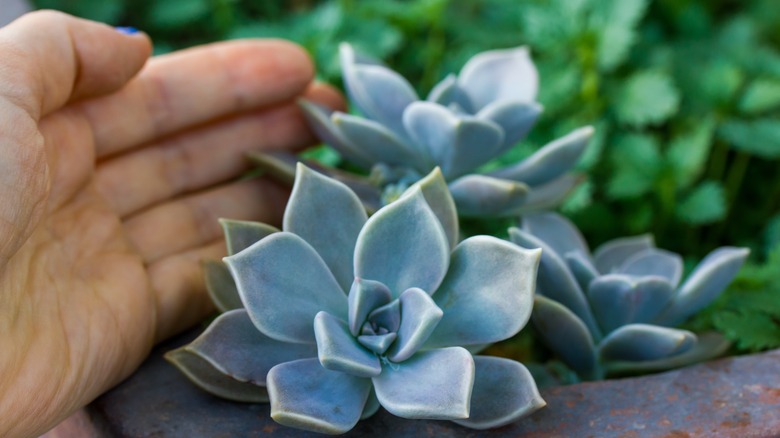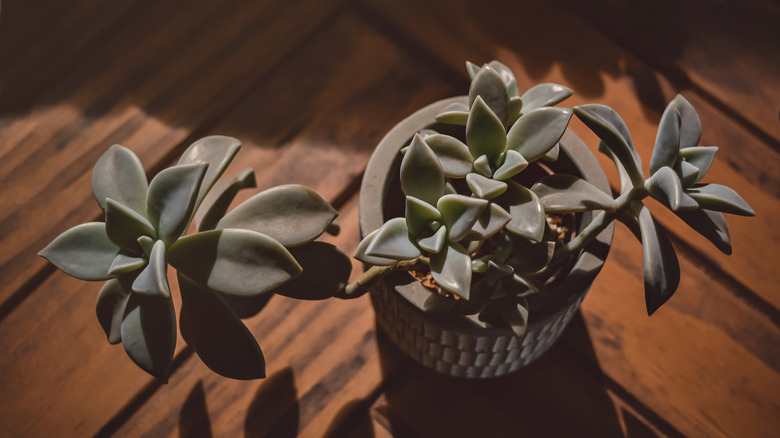The Crucial Mistake You Don't Want To Make With Your Ghost Plant
Succulents are some of the best options on the market for newbie plant parents, as they are extremely low maintenance and can survive across many different living situations. Their versatility allows them to grow almost anywhere, from a potter placed in a bedroom window sill to a makeshift succulent garden in your backyard. Ghost plants are a hardy type of succulent capable of surviving even the most extreme of environmental conditions like droughts and temperatures dropping well below freezing. The one thing you'll want to avoid though is placing your ghost plant in a space where it'll see little to no sunlight, lest it'll begin to turn pale or start to grow fewer leaves and elongated stems.
If you've already placed your ghost plant or other type of succulent in an area lacking adequate sun, don't stress. Succulents may survive for more than 14 days without proper exposure to sunlight, but any lack of action following this time period may lead to changes in the plant's growth patterns. Some succulents are more tolerant of shade than others, but that doesn't mean you should establish the habit of keeping them in the dark. On average, the plants need at least four to six hours of indirect sunlight daily to survive, but the more attention they receive from the sun each day, the better.
How to know if your ghost plant is receiving enough sun
Although ghost plants can survive in a plethora of environments because of their hardiness and low-maintenance nature, sunlight is one factor that absolutely cannot be excluded from ghost plants' list of necessities. They love basking in the sun, but can also succumb to overexposure if not careful.
Luckily for beginner gardeners, ghost plants will let you know if they're not receiving enough sun. If your plant is growing a lot of stems without blooms on them, this could be a sign that more sun is needed. If your plant is kept in partial sun, expect the succulent leaves to turn a bluish-green color. Alternatively, ghost plants may turn a yellowish-pink hue when receiving uninterrupted sun over time. The plant may also start to stretch its stem upward if deprived of sunlight for too long, as a way of adjusting to its environment as it searches for an energy source. Additionally, the plant's lower leaves may begin to curl and point toward the ground when craving the sun's warmth, due to its missing out on the key nutrients that it normally receives from exposure to light.
How to care for a ghost plant
Raising ghost plants is far from complicated, as there are only a few instructions you need to keep in mind when growing them. If choosing to grow them outside, gardeners should tailor their care depending on the climate conditions of their region, since the amount of moisture and sunshine an area receives heavily impacts the way your plants mature.
Ensure your ghost plant sees at least six hours of light every day, but for the best results, place them in direct sunlight for even longer periods of time. These succulents will also fare well placed in indirect sunlight or partial shade, although the more light you can offer, the better. Though succulents need consistent exposure to the sun's rays in order to survive, it's also possible for the plants to receive too much sun, usually manifesting in the form of dark spots across the leaves. Ghost plants are less likely to suffer from this issue compared to more sensitive succulents, but look out for discoloration regardless.
Be very careful when watering your ghost plants since they only need to be watered every so often. Also plant them in soil that drains well, as they are susceptible to root rot if water is left to pool at the bottom of the planter. Rather than following a strict schedule to water your ghost plant, try waiting until the potting soil is completely dry to the touch before giving your succulent another drink.


